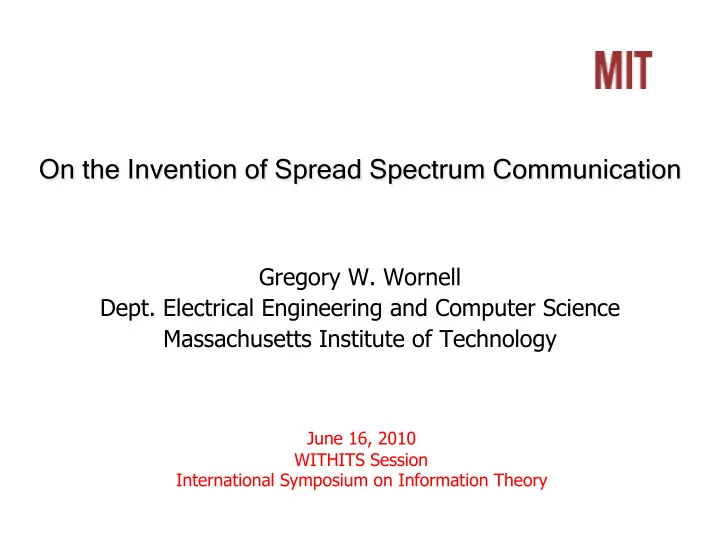

Gregory W. Wornell Dept. Electrical Engineering and Computer Science Massachusetts Institute of Technology June 16, 2010 WITHITS Session International Symposium on Information Theory
How can radio-control of torpedoes be made jam-resistant?
Frequency-hopped spread spectrum.
• Hedwig (Hedy) Eva Maria Kiesler, b. 1913, Vienna • high-school dropout with mathematical bent • in 1930, started studying acting in Berlin • in 1932 (age 19), appears in Czech film Ecstacy • made worldwide cinematic history for what was not in the film • in same year, married Fritz Mandl – older, wealthy, prominent, (and domineering) Austrian munitions dealer (to Germany and Italy) • spent time helping entertain customers; learned about weapon systems engineering
• becomes disenchanted with Mandl, and Nazis • escaped from her maid, ended up in Hollywood via London; new life • signs with Louis Mayer (MGM), 1939 • new name (Lamarr), “wholesome” films, star • gets involved with composer George Antheil • Antheil uses 16 player pianos in sync in a concert • she makes a connection to anti-jam torpedo radio control • patent enbodiment uses Tx and Rx player piano rolls perforated with identically (88-frequency) hopping patterns
“…it is veritably impossible for an enemy vessel to `jam’ or in any way interfere with the radio-direction of such a previously synchronized torpedo because, simply, no ship may have enough sending stations aboard or nearby to `jam’ every air-wavelength possible or to otherwise succeed except by barest accident to deflect the course of the oncoming radio controlled torpedo – unless, of course, it happened to have the exact synchronization pattern between sender-ship and torpedo.”
• Navy couldn’t use – 20 years ahead of its time • gave the patent to the US government; turned to promoting war bonds • patent withheld from public until 1981 • cited by >1000 US Patents as prior art • Sylvania enabled with transistor circuit, 1957 • first used in the 1962 Cuban embargo • concept now used everywhere, from Milstar to IS-95 to bluetooth
• Bob Price (RAKE receiver) learned of Lemarr’s invention from his (author) sister, who’d run across her name • about the time the patent was declassified (1981) • wasn’t known at the time of Scholz’ “Origins of Spread- Spectrum Communications” May 1982 TCOM article • Price interviewed Lemarr August 1982; appeared in Price’s “Further Notes and Anecdotes” follow-up Jan. 1983 TCOM article • son accepted 1997 Electronic Frontier Foundation Award for “contribution to pioneering electronics” on her behalf; she lived (modestly) until 2000
• the value of taking the path less chosen, an independent streak, and being self-sufficient and resourceful • didn’t “play it safe”; wits, confidence, instinct • the aesthetic appeal of practical solutions to real problems, and the satisfaction that accompanies their pursuit • just as much theory as needed and no more • the dignity of life without self-promotion • dedication to a broader cause than personal gain
Recommend
More recommend